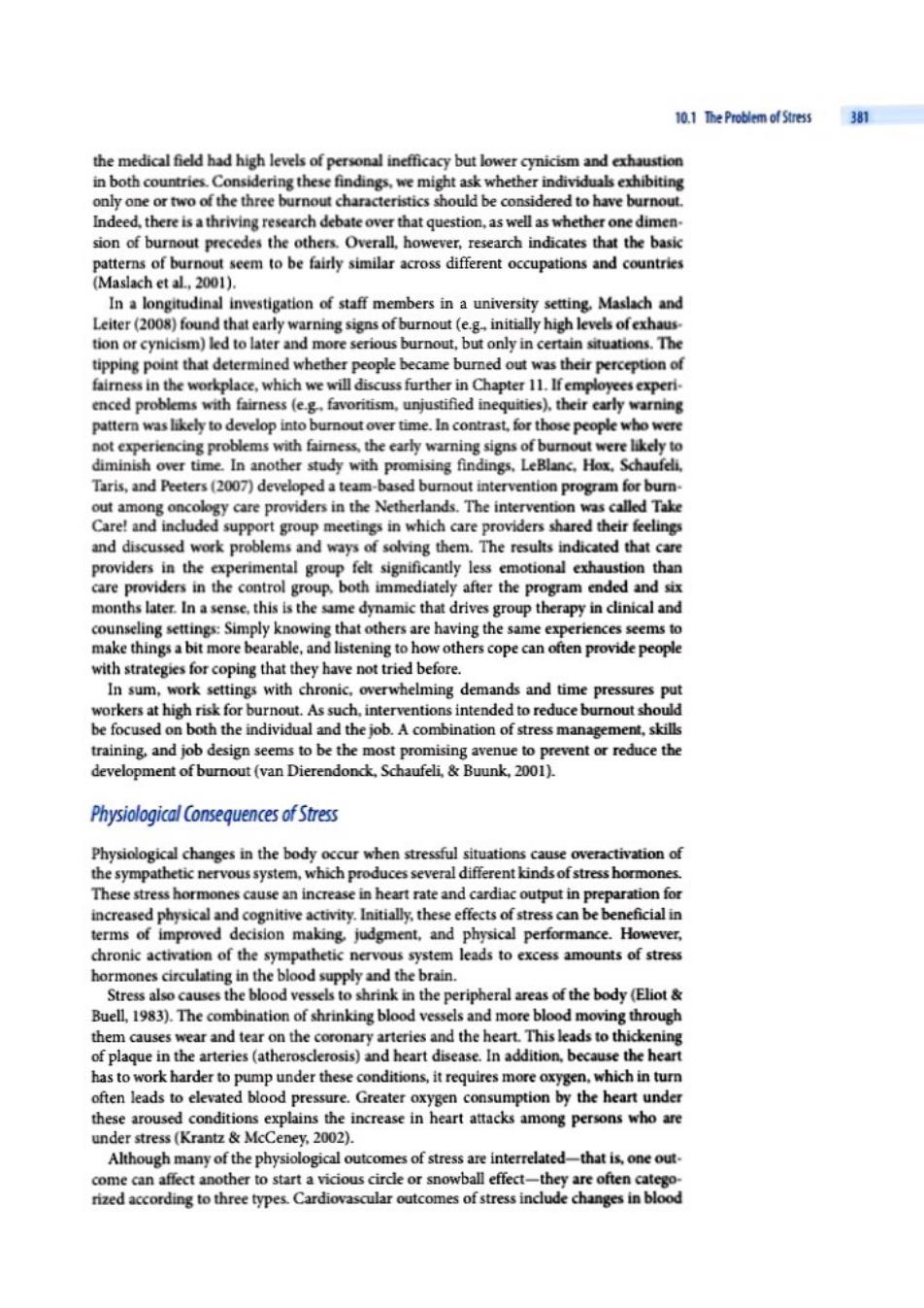正在加载图片...

10.1 The Problem of Stress 381 the medical field had high levels of personal inefficacy but lower cynicism and exhaustion in both countries.Considering these findings,we might ask whether individuals exhibiting only one or two of the three burnout characteristics should be considered to have burnout. Indeed,there is a thriving research debate over that question,as well as whether one dimen. sion of burnout precedes the others.Overall,however,research indicates that the basic patterns of burnout seem to be fairly similar across different occupations and countries (Maslach et al.,2001). In a longitudinal investigation of staff members in a university setting.Maslach and Leiter (2008)found that early warning signs of burnout(e.g.initially high levels of exhaus- tion or cynicism)led to later and more serious burnout,but only in certain situations.The tipping point that determined whether people became burned out was their perception of fairness in the workplace,which we will discuss further in Chapter 11.If employees experi- enced problems with fairness (e.g.favoritism.unjustified inequities).their early warning patter was likely to develop into burnout over time.In contrast,for those people who were not experiencing problems with faimess,the early warning signs of burout were likely to diminish over time.In another study with promising findings.LeBlanc,Hox.Schaufei. Taris,and Peeters(2007)developed a team-based burout intervention program for burn. out among oncology care providers in the Netherlands.The intervention was called Take Care!and induded support group meetings in which care providers shared their feelings and discussed work problems and ways of solving them.The results indicated that care providers in the experimental group felt significantly less emotional exhaustion than care providers in the control group,both immediately after the program ended and six months later.In a sense.this is the same dynamic that drives group therapy in clinical and counseling settings:Simply knowing that others are having the same experiences seems to make things a bit more bearable,and listening to how others cope can often provide people with strategies for coping that they have not tried before. In sum,work settings with chronic,overwhelming demands and time pressures put workers at high risk for burnout.As such.interventions intended to reduce burnout should be focused on both the individual and the job.A combination of stress management,skills training,and job design seems to be the most promising avenue to prevent or reduce the development of burnout (van Dierendonck.Schaufeli,Buunk,2001). Physiological Consequences of Stress Physiological changes in the body occur when stressful situations cause overactivation of the sympathetic nervous system,which produces several different kinds ofstress hormones. These stress hormones cause an increase in heart rate and cardiac output in preparation for increased physical and cognitive activity.Initially,these effects of stress can be beneficial in terms of improved decision making judgment,and physical performance.However, chronic activation of the sympathetic nervous system leads to excess amounts of stress hormones circulating in the blood supply and the brain. Stress also causes the blood vessels to shrink in the peripheral areas of the body (Eliot Buell,1983).The combination of shrinking blood vessels and more blood moving through them causes wear and tear on the coronary arteries and the heart.This leads to thickening of plaque in the arteries(atherosclerosis)and heart disease.In addition,because the heart has to work harder to pump under these conditions,it requires more oxygen,which in turn often leads to elevated blood pressure.Greater oxygen consumption by the heart under these aroused conditions explains the increase in heart attacks among persons who are under stress(Krantz McCeney,2002). Although many of the physiological outcomes of stress are interrelated-that is,one out. come can affect another to start a vicious circle or snowball effect-they are often catego- rized according to three types.Cardiovascular outcomes of stress include changes in blood